Sven Hassel was the pen name of the Danish-born Børge Willy Redsted Pedersen known for his novels about German soldiers fighting in World War II. In Denmark he used the pen name Sven Hazel. He is one of the bestselling Danish authors, possibly second only to Hans Christian Andersen.
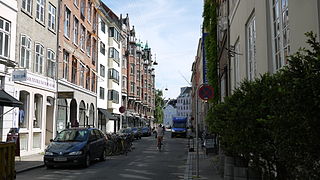
Store Strandstræde is a street in Copenhagen, Denmark. It extends diagonally from Kongens Nytorv, at the corner of Nyhavn and Bredgade, to Sankt Annæ Plads. Lille Strandstræde joins the street shortly before reaching Sankt Annæ Plads.

Sankt Annæ Plads is a public square which marks the border between the Nyhavn area and Frederiksstaden neighborhoods of central Copenhagen, Denmark. It is a long narrow rectangle which extends inland from the waterfront, at a point just north of the Royal Danish Playhouse at the base of the Kvæsthus Pier, now known as Ofelia Plads, until it meets Bredgade. A major renovation of the square was completed in 2016.The Garrison Church is located on the south side of the square. Amaliegade, one of the two axes on which Frederiksstaden is centered, extends from the square.
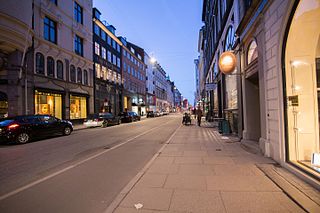
Bredgade is one of the most prominent streets in Copenhagen, Denmark. Running in a straight line from Kongens Nytorv for just under one kilometre to the intersection of Esplanaden and Grønningen, it is one of the major streets in Frederiksstaden, a Rococo district laid out in the middle of the 18th century to commemorate the tercentenary of the House of Oldenburg's accession to the Danish throne. It is lined with a number of fine mansions as well as other historic buildings. Many law firms, trade unions, fashion stores and art galleries are based in the street. The street also runs parallel to the Royal residence Amalienborg and Frederik's Church

Gothersgade is a major street in the City Centre of Copenhagen, Denmark. It extends from Kongens Nytorv to Sortedam Lake, passing Rosenborg Castle and Gardens, Nørreport Station and Copenhagen Botanic Gardens on the way.
Events from the year 1811 in Denmark.
Events from the year 1857 in Denmark.

The Lindencrone Mansion is a historic building located on the corner of Bredgade and Sankt Annæ Plads in central Copenhagen, Denmark. Completed in 1753, it is one of many town mansions which were built for wealthy citizens in the district Frederiksstaden in the years after its foundation in the middle of the 18th century.

The Copenhagen Amber Museum is a museum on Kongens Nytorv in central Copenhagen, Denmark. The museum is owned by House of Amber. The museum holds an extensive collection of amber antiques and artifacts, including a wide array of entombed insects from prehistoric times. The collection comprises one of the largest piece of amber in the world.
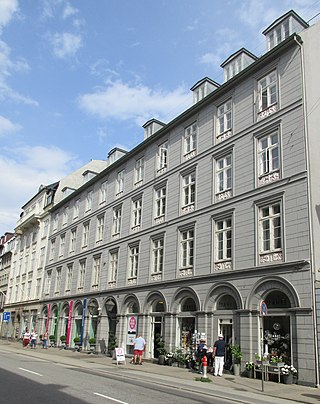
The Grandjean House is a Late Neoclassical property consisting of two separate buildings, one at Bredgade 4 and one at Store Strandstræde 3, on opposite side of a central courtyard, in central Copenhagen, Denmark. The property is separated from Kongens Nytorv by a small building that now houses Copenhagen Amber Museum. It was built in 1854 by the architect Christian Tybjerg for pastry chef Christian Bredo Grandjean. It replaced an older building, which was known as the Collin House after Hans Christian Andersen patron Jonas Collin, but this name is now associated with another building in Amaliegade. The Grandjean House was listed on the Danish registry of protected buildings and places in 1959.

The Ziegler House, located at the corner of Nybrogade and Knabrostræde, is an 18th-century Rococo-style, bourgeoisie townhouse overlooking Slotsholmens Kanal and Slotsholmen in central Copenhagen, Denmark. The building was designed by Philip de Lange and formerly also known as Eneretsgården.
Hotel Phoenix Copenhagen is a hotel located at the corner of Bredgade and Dronningens Tværgade in Copenhagen, Denmark. The first Hotel Phoenix opened at the site in 1848 but closed when it was confiscated by the Germans during World War II. The building was after the war converted into a new headquarters for the Danish Communist Party and the newspaper Land og Folk. The building was acquired by Arp-Hansen Hotel Group in 1990 and reopened as a hotel the following year.. It is mentioned in Jules Verne's Journey to the Center of the Earth,

The Royal Danish Silk Manufactury was located at Bredgade 34 and 36 in Copenhagen, Denmark. The building fronting the street at No. 34 was listed on the Danish registry of protected buildings and places by the Danish Heritage Agency on 12 March 1951. The rear wings and the building at No.36 are not listed.

The Løwe House is an 18th-century townhouse located at Bredgade 76 in the Frederiksstaden neighborhood of central Copenhagen, Denmark. The Royal Danish Naval Academy was based in the building from 1827 to 1865. It was listed on the Danish registry of protected buildings and places by the Danish Heritage Agency on 22 June 1991.
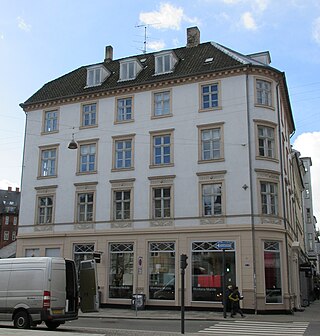
Bredgade 24 is a listed building located at the corner of Bredgade and Sankt Annæ Plads in central Copenhagen, Denmark. The building was listed on the Danish registry of protected buildings in 1987. Notable former residents include painter and photographer Niels Christian Hansen.

Arent Nicolai Dragsted was a Danish goldsmith based in Copenhagen who was granted the predicate Purveyor to the Court of Denmark shortly before his death. His company, A. Dragsted, still exists today. Dragsted created the golden horn that was presented to Bernhard Severin Ingemann by Danish women on the occasion of his 75 years birthday. The horn is now on display in the Danish Museum of National History at Frederiksborg Castle in Hillerød. He has also created the golden wreath for Frederick VIIøs sarcofague in Roskilde Cathedral.

Store Mariendal was a country house at Strandvejen 135 in Hellerup, on the border between Copenhagen and Gentofte municipalities, Copenhagen, Denmark. It was operated as a hotel and entertainment venue in the 1900s and 1910s and served as the residence of Prince Viggo from 1931 to 1970. The building was demolished in 1977 and a housing estate with 121 apartments by the same name is now located at the site.

Kaspar Rostrup was a Danish lawyer, joiner and local politician. From 1886, he was the owner of N. P. Rostrup, a Copenhagen-based coffin manufacturer and retailer headquartered at Valkendorfsgade 36. He was a member of the Copenhagen City Council from 1894 to 1900, as well as president of the Association of Craftsmen in Copenhagen from 1896 and of the Confederation of Danish Employers from 1907 to 1911.

Bredgade 63–65 are two identical Renaissance Revival style properties situated on Bredgade, adjacent to the small garden complex in front of Østre Landsret, in the Frederiksstaden of central Copenhagen. Denmark. Both buildings were individually listed in the Danish registry of protected buildings and places in 1988. The Mexican Embassy is based at No. 65.
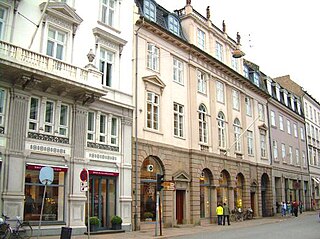
The Prior House, situated at Bredgade 33, opposite Sankt Annæ Plads, is the current headquarters of the Bruun Rasmussen auction house in Copenhagen, Denmark. The Neoclassical building was conjstructed in 1794 for a ship captain by master mason Andreas Hallander. It contained a single high-end apartment on each of the three upper floors. The building takes its name after businessman and ship-owner Hans Peter Prior, its owner from 1850 until his death 25 years later, whose shipping company DFDS was initially based in the building. One of Prior's sons was the sculptor Lauritz Prior. In 1864, Prior charged the architect Wilhelm Petersen with the design of a three-storey atalier building for the son. Prior's Atelier Building is decorated with a series of reliefs created by Lauritz Prior. It was after his death used by a number of other leading Danish artists of the late 19th and early 20th century, including Peder Severin Krøyer, Lauritz Tuxen, Carl Bloch, Frants Henningsen and Edvard Weie. Kunstnernes Frie Studieskoler, an art school founded by Krøyer and Tuxen as an alternative to that of the Royal Danish Academy of Fine Arts, was initially based in the building. The Prior House remained in the hands of the Prior family for almost one hundred years. In 1847, Bredgade 33 was acquired by Bruubn Rasmussen-founder Arne Bruun Rasmussen, whose auction house has since then been headquartered in the building. Other notable former residents include the naval officers Johann Christopher Hoppe, Jost van Dockum and Edouard van Dockum, government officials Johann Paul Høpp and Friedrich Nicolaus von Liliencron, writer Adam Oehlenschläger and politician Orla Lehmann.

















